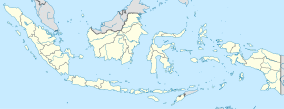Tanjung Puting National Park
| Tanjung Puting National Park | |
|---|---|
|
IUCN category II (national park)
|
|

Vegetation at Sekonyer river.
|
|
| Tanjung Puting National Park in Borneo | |
| Location | West Kotawaringin Regency, Kalimantan, Indonesia |
| Nearest city | Pangkalan Bun |
| Coordinates | 3°03′S 111°57′E / 3.05°S 111.95°ECoordinates: 3°03′S 111°57′E / 3.05°S 111.95°E |
| Area | 4,150 km2 (1,600 sq mi) |
| Established | 1982 |
| Visitors | 2,046 (in 2007) |
| Governing body | Ministry of Forestry |
Tanjung Puting National Park is a national park in Indonesia located in the southeast part of West Kotawaringin Regency in the Indonesian province of Central Kalimantan (Central Borneo). The nearest main town is the capital of the Regency, Pangkalan Bun. The park is famous for its orangutan conservation.
The park is composed of 416,040 hectares of dryland dipterocarp forest, peat swampforest, heath forest, mangrove and coastal beach forest, and secondary forest. The park may be accessed from Kumai by speedboat along the Kumai River and then the Sekonyer River to Camp Leakey, a journey that takes about 1.5 hours. The Kumai River forms the northern border of the park. Beyond that the peat forest has been removed to make way for oil palm plantations.
Despite being a protected national park, approximately 65% of the park's primary forest is degraded. It is the loss of natural habitat that is the greatest threat to the wildlife. Friends of National Parks Foundation is an Indonesian NGO that has been working to restore the habitat in the Pasalat and Beguruh regions of the park since 1997. It also operates a conservation education centre in Pasalat.
Four research centers have been established within the park for the study and rehabilitation of orangutans and other primates. Camp Leakey, founded in 1971 with assistance from the Leakey Foundation, was the first of these centers. It was here where Dr. Birute Galdikas began her career studying the behavior of rescued and orphaned orangutans that were reintroduced into the wild. Her research was highlighted as the cover article of National Geographic in October 1975. Dr. Galdikas is now considered one of the world’s leading experts on orangutan behaviour and is the founder and president of the Orangutan Foundation International.
The park was set aside in the 1930s by the Dutch colonial government for the protection of the orangutans and proboscis monkey, and was designated as a UNESCO Biosphere Reserve in 1977 and a national park in 1982.
...
Wikipedia

